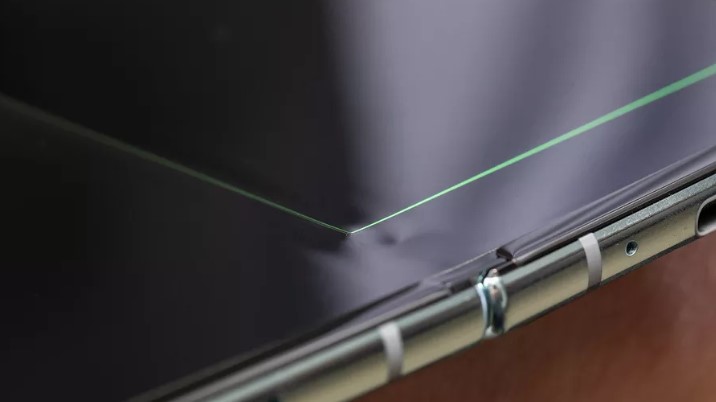
Samsung has released an official statement addressing reports of display issues with the upcoming Galaxy Fold. There are two parts to the story, and unfortunately only one of those parts offers real answers.
First, Samsung notes that it intends to “thoroughly inspect [the review] units in person,” referring to the devices that seemed to have had screens break without a direct, obvious cause. Our review unit developed a bulge that appeared to be the result of something in between the screen and the hinge, ultimately breaking the screen. So we don’t have a clear answer there yet.
Separately, Samsung addressed the issue of screens breaking because reviewers had attempted to peel off a protective plastic layer that was adhered to the screen itself. Though it looks like a screen protector and seems like a natural thing to try to remove, it shouldn’t be. Here’s Samsung’s statement, in full:
A limited number of early Galaxy Fold samples were provided to media for review. We have received a few reports regarding the main display on the samples provided. We will thoroughly inspect these units in person to determine the cause of the matter.
Separately, a few reviewers reported having removed the top layer of the display causing damage to the screen. The main display on the Galaxy Fold features a top protective layer, which is part of the display structure designed to protect the screen from unintended scratches. Removing the protective layer or adding adhesives to the main display may cause damage. We will ensure this information is clearly delivered to our customers.
While the clarity surrounding the screen protector is helpful, the lack of a clear answer as to what broke both our unit and at least one other Galaxy Fold screen is troubling. As we noted in the previous article, we returned our broken unit to Samsung for inspection and have been waiting to hear what the cause of the breakage was.
Reports of issues with the Galaxy Fold came just days after review units of the upcoming foldable device made their way out into the world. Since then, multiple outlets have reported issues with the device — including The Verge, which saw our review unit break after just a day of use when (we think) a piece of debris got lodged under the folding display and damaged the OLED panel. Prior to release, Samsung said it performed rigorous tests on the Galaxy Fold’s display, promising the flexible screen would “outlast 200,000 folds and unfolds.” But the claim doesn’t seem to hold up following real world use.
Some of the problems with the display may have been avoidable — several reviewers reportedly peeled off an outer “polymer layer” for the display that resembles a screen protector, but is in fact a crucial part of the screen. To its credit, Samsung is already warning users not peel off that layer, at least on the retail T-Mobile version, yet it seems that a more robust warning may be needed. And even if that is the case, it still doesn’t explain all the failed units, some of which encountered problems despite the owner not having removed the polymer layer.
Given that the Galaxy Fold costs $1,980, seeing such critical failures pop up ahead of the official launch isn’t reassuring.
The Galaxy Fold’s screen failures aren’t the worst disaster for Samsung in recent memory — that title still goes to the Galaxy Note 7, which Samsung ultimately had to recall entirely and cancel production due to exploding batteries. To this day, you still can’t bring a Note 7 on a commercial airplane.
There’s also a lot riding on the Galaxy Fold. Samsung is trying to win the race to market with the first mainstream foldable device and what may be the only high-profile folding phone released in the United States for quite some time. A stumble of this magnitude this early out of the gate is a worst-case scenario for Samsung here, blackening the eye of the company not just for the Galaxy Fold, but for the entire foldable phone market.
Despite Samsung’s statement, it’s unclear what the underlying problem with the Galaxy Fold’s display was, and whether or not Samsung will be able to address it in time for launch, or even at all.
